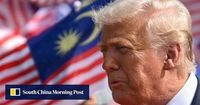The global race for rare earth elements, the critical minerals underpinning everything from electric vehicles to advanced military systems, has entered a new and fiercely contested phase. On October 27, 2025, the United States signaled a dramatic escalation in its efforts to secure these vital resources, unveiling a series of sweeping initiatives and international partnerships designed to break its dependence on China—the world’s dominant supplier of rare earths. With new export controls from Beijing looming and the specter of supply chain disruption haunting Western industries, Washington is moving quickly to redraw the map of global mineral sourcing.
China’s stranglehold on the rare earths market is nothing short of formidable. According to Goldman Sachs, the country controls around 70% of global mining, an astonishing 92% of refining, and a near-monopoly of 98% in magnet production. These magnets, composed of elements like neodymium and dysprosium, are essential for the motors in electric vehicles, the guidance systems of F-35 fighter jets, and even the MRI machines found in hospitals. As U.S. Global Investors put it, rare earths are “the sinews of the modern world.”
Yet, with power comes leverage. In April 2025, Beijing imposed export controls on several rare earth elements, weaponizing its mineral dominance amid escalating geopolitical tensions. Then, on October 27, China announced its most sweeping export restrictions yet, effective December 1. Any company seeking to export goods containing more than 0.1% of their value from Chinese-sourced rare earths must now apply for a government license. Even more consequential, products using Chinese rare-earth technology—be it mining, refining, or magnet fabrication—will also fall under these stringent controls. According to U.S. Global Investors, these rules effectively block supply chains linked to foreign defense contractors, allowing Beijing to “veto the flow of materials that go into America’s most advanced weapons systems.”
The ramifications for U.S. industry are profound. Goldman Sachs has warned that a mere 10% disruption in rare earth supply could wipe out $150 billion in global output, rippling across the semiconductor, electric vehicle, and defense sectors. American electric vehicle makers, in particular, are heavily reliant on rare earth metals—a vulnerability that Washington can no longer afford to ignore.
In response, the U.S. has launched a multi-pronged strategy to secure alternative supplies and processing capacity. The centerpiece of this effort is a deepening partnership with Australia, a country blessed with some of the world’s richest rare earth deposits and a proven track record as a reliable ally. On October 27, the U.S. Export-Import Bank (EXIM) issued a letter of interest to fund up to $200 million for VHM’s Goschen Rare Earths and Mineral Sands Project in Victoria. This follows a $67 million EXIM commitment in September for Sunrise Energy Metals’ scandium project in New South Wales. Both ventures are now integral to Washington’s "Supply Chain Resiliency Initiative," a policy designed to reroute critical inputs through trusted partners and reduce exposure to Chinese supply risks, as detailed by Metal Miner.
The Goschen project stands out as a strategic asset in this new industrial landscape. With over 413,000 tons of total rare earth oxide and a proven ore reserve of 199 million tons, it is designed to supply both light and heavy rare earths, along with valuable mineral sands like zircon and rutile. These materials are essential not only for clean energy technologies but also for defense systems. The project has already cleared major regulatory hurdles, including environmental approvals and a mining license, and benefits from robust infrastructure and logistics in a Tier 1 jurisdiction. As VHM CEO Andrew King put it, EXIM’s decision represents “a globally significant move to resolve current supply chain vulnerabilities.”
Australia’s role doesn’t end there. In October, U.S. President Trump and Australian Prime Minister Anthony Albanese signed the U.S.-Australia Critical Minerals Framework Agreement, pledging at least $1 billion in near-term financing to build processing capacity and reduce dependence on China. The Export-Import Bank is also reviewing a $300 million financing package for Arafura Rare Earths’ Nolans project, with Canberra adding another $100 million. Over the next decade, the two nations plan to co-fund an $8.5 billion pipeline of critical minerals projects. Notably, Lynas Rare Earths, an Australian producer, became the first company outside China to produce commercial quantities of dysprosium oxide, a heavy rare earth crucial for defense magnets, in May 2025, according to U.S. Global Investors.
But Australia is not the only new partner in America’s rare earth strategy. On October 27, the U.S. signed Memorandums of Understanding (MOUs) with Malaysia and Thailand, aiming to develop alternative sources of rare earth metals. While experts such as Charles Chang of Fudan University caution that these agreements will require industry support and time to develop processing capacity, the deals are seen as a vital hedging strategy. Jon Hykawy, president of Stormcrow Capital, told the South China Morning Post, “If they can get those materials from Malaysia and Thailand, which means that the US puts concrete plans in place to actually buy those materials on long-term contracts, and they put the downstream processing in place, then an agreement will help.”
This diversification is crucial, as China currently accounts for about 70% of global mining and 90% of processing output for rare earth metals, according to the Center for Strategic and International Studies. The MOUs with Southeast Asian nations could eventually help reduce U.S. dependence on China in the event of a prolonged trade dispute, especially as American industries scramble to lock in alternative supply chains.
Meanwhile, the U.S. is also looking northward, intensifying its interest in Greenland’s rare earth reserves. The Tanbreez deposit, for example, is particularly rich in heavy rare earth elements—those most critical for high-performance applications. Greenland’s unique geopolitical status as a semi-autonomous territory of Denmark in the Arctic adds another layer of strategic significance to these efforts, as noted by Metal Miner.
On the home front, the U.S. government is making direct investments to shore up domestic production. The Department of Defense recently made a $400 million equity investment in MP Materials, America’s sole large-scale rare earth miner, establishing a price floor for neodymium-praseodymium magnets and guaranteeing offtake for defense supply chains. The DoD is now the company’s largest shareholder, underscoring the national security imperative behind these moves.
Some skeptics point to the daunting challenges ahead—processing capacity takes time to build, environmental approvals can be slow, and China’s entrenched dominance won’t be easy to dislodge. But history offers a lesson in resilience. In the 1980s, the U.S. semiconductor industry faced a similar crisis when Japan’s government-backed chipmakers threatened to overrun the market. Through a mix of tariffs and strategic agreements, the U.S. managed to regain its competitive edge. As President Trump recently declared, this is the "gold rush of the 21st century." But unlike the gold of old, the new prize is magnetic—and the stakes are higher than ever.
As the world’s economic and technological future increasingly hinges on the secure supply of rare earth elements, the U.S. and its allies are racing to ensure they’re not left vulnerable to geopolitical shocks. The coming months will reveal whether these bold new strategies can truly reshape the rare earth landscape—or if China’s grip will prove too strong to break.




